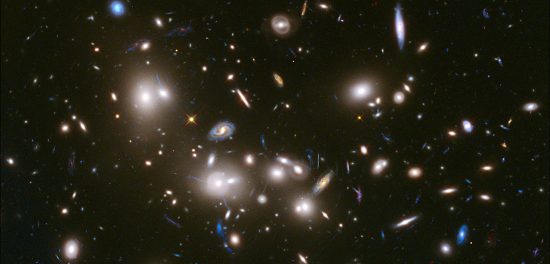
September 8, 2020
There are regular reports in the scientific press about the filamentary structure of the Universe.
According to consensus astrophysics, galaxies are embedded in a diffuse cloud of gas and dust known as “baryonic matter”. Baryons are commonly referred to as “normal matter”, or “luminous” matter. However, along with baryons, there is supposed to be concentration of “non-baryonic matter”, otherwise known as “dark matter”, comprising more than 80% of all mass.
It is believed that dark matter is essential to the large-scale evolution of the Universe, since some theories state that there is not enough gravity in a baryon-only Universe for galaxies to form. In 1933, Fritz Zwicky found that his calculations for orbital acceleration and stellar mass within galaxies were off by a factor of about 160. He thought that something invisible to his instruments was holding the cluster together. That “something” later became known as dark matter.
Dark matter cannot be detected by any instrument, so astronomers think they can see its influence on visible matter. Since many galaxies and nebulae emit intense radiation, the gases and dust around them absorb energy, re-emitting it in the from of “Lyman-alpha band” ultraviolet light. It is in that glow from nebulae that astronomers see indications of a filamentary structure.
Quantum mechanics posits that electrons are attracted to nuclear protons by their “binding energy.” Each electron orbit possesses its own binding energy value expressed in “electron volts.” The closer an electron is to a hydrogen atom’s nucleus, the greater the binding energy. As an electron jumps from an orbit (“n”) with a lower binding energy to an orbit with greater energy (n2 to n1 for example), it emits light at a specific ultraviolet frequency. Light from the n2 to n1 jump corresponds to 121.6 nanometers and is called “Lyman-alpha” radiation, named for Theodore Lyman.
The Universe is most likely built from threads of matter. However, those threads are electrical in nature and not gravitational. One of the principal tenets of Electric Universe theory is that electricity flowing through ionized gas, otherwise known as plasma, creates long electromagnetic filaments called Birkeland currents. Birkeland currents attract one another in a one over the square root of r relationship that is more powerful than gravity. That means they are the strongest long-range attractors in the Universe.
In an Electric Universe, nebulae, as well as other celestial formations, no matter their scale, can be more properly identified with the glow from a gas discharge tube—similar to a neon lamp. An electric discharge through plasma forms double layers along the current axis. Positive charge builds up on one side and negative charge on the other side of this “sheath.” An electric field develops between the sides, and if enough current is applied the sheath glows, otherwise it is invisible. Electric currents flow within and across the sheaths.
Electric sheaths that are normally invisible are “pumped” with additional energy from Birkeland currents in which they are immersed. Electromagnetic forces draw matter from the surrounding space into filaments. The electrical power pushes them into “glow mode.” The “cosmic web” is an electric web.
Stephen Smith
The Thunderbolts Picture of the Day is generously supported by the Mainwaring Archive Foundation.












